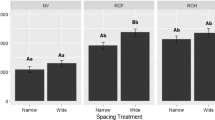Abstract
Interplanting Gliricidia (Gliricidia sepium [Jacq.] Walp.) into poor quality native grass can improve the quality of pasture. But information on methods to establish the tree legume into existing pasture is scarce. This study was designed to compare the effects of disc-ploughing, hoeing, or rotary tillage operations, and direct seeding or planting out potted seedlings on growth and dry matter yields of Gliricidia in grass pasture. The Guinea grass (Panicum maximum) pasture was first mowed to a height of 10 cm. Then the seedbed was prepared by either hoeing 0.5 m strip or rototilling 0.5 m strip with a 2-wheel tractor or disc-ploughing 1.0 m strip with a 4-wheel tractor. Eight weeks old potted seedlings were planted or seeds were sown direct. At 6 months after planting (MAP), trees in disc-ploughed strips averaged 81 cm in height, about 35% taller than trees in hoed- or rotary-tilled strips. Potted seedlings (average height 77 cm) grew 37% taller than direct-seeded trees. At 12 MAP trees in disc-ploughed strips yielded 95% more leaf DM (1170 vs. 600 kg/ha) than trees in hoed- or rotary-tilled strips. In order to intercrop Gliricidia into existing Guinea grass pasture, it is necessary to plant potted seedlings previously raised in nursery into 1.0 m wide strips disc-ploughed with 4-wheel tractor. Weed control is necessary.
Similar content being viewed by others
References
Agboola AA, Wilson GF, Getahum A and Yamoah CF (1984)Gliricidia sepium: A possible means to sustained cropping. In: MacDonald LH (ed) Agroforestry in African Humid Tropics, pp 141–143. The United Nations University, Tokyo, Japan
Borough CF (1979) Agroforestry in New Zealand — the current situation. Aust For 42: 23–29
Chadhokar PA and Kantharaju HR (1980) Effect of Gliricidia maculata on growth and breeding of Bannur ewes. Trop Grassl 14: 78–82
Chadhokar PA and Lecamwasam A (1982) Effect of feeding Gliricidia maculata to milking cows: a preliminary report. Trop Grassl 16: 46–48
Cobbina J, Reynolds L and Couper DC (1991) Establishment practices for Gliricidia in existing Panicum maximum pasture in humid tropical environments. In: Proceedings of the 4th International Rangeland Congress, 22–26 April, 1991, Montpellier, France (Abstract)
Cook SJ (1984) Establishment of four pasture grasses and Siratro from seed oversown into dense and open speargrass pastures. Aust J Exp Agric Anim Husb 24: 360–369
Cook SJ, Crega PD, Campbell MH and Read JW (1987) Tillage — its role in establishment and management of pastures. In: Cornish PS and Pratley JE (eds) Tillage: New Directions in Australian Agriculture, pp 94–125. Australian Society of Agronomy and Inkata Press, Melbourne, Australia
Cook SJ and Ratcliff D (1985) Effect of fertilizer, root and shoot competition on the growth of Siratro (Macroptilium atropurpureum) and green panic (Panicum maximum var, trichoglume) seedlings in a native speargrass (Heteropogon contortus) sward. Aus J Agric Res 36: 233–345
Hoen K (1968) The effect of plant size and development stage on summer survival of some perennial grasses. Aust J Exp Agric Anim Husb 8: 190–196
Hyder DN and Sneva FA (1956) Herbage response to sagebrush spraying. J Range Manage 15: 211–215
Kang BT, Reynolds L and Atta-Krah AN (1990) Alley farming. Adv Agron 43: 315–359
Lowry JB, Lowry JBC and Jones RJ (1988) Enchanced grass growth below the canopy of Albizia lebbek. Nitrogen Fixing Tree Res Rep 6: 45–46
McKell CM (1989) The role of shrubs in plant community diversity. In: McKell CM (ed) The Biology and Utilization of Shrubs, pp 307–320. Academic Press Inc, San Diego, USA
Moormann FR, Lal R and Juo ASR (1975) The soils of IITA. Technical Bulletin 3. International Institute of Tropical Agriculture, Ibadan, Nigeria
Raney WA and Zingg AW (1957) Principles of tillage. In: Soil: The Yearbook of Agriculture, pp 277–281. The United States Department of Agriculture, Washington, DC, USA
Russell RS (1977) Plant Root Systems: their Function and Interaction with the Soil: McGraw-Hill, London
SSSA (1987). Glossary of Soil Science Terms. Soil Science Society of America, Madison, USA
Steel RGD and Torrie JH (1980) Principles and Procedures of Statistics. A Biometrical Approach. 2nd Ed. McGraw-Hill Book Co, New York
Van Epps GA and McKell CM (1977) Shrubs plus grass for livestock forage: a possibility. Utah Sci 38: 75–78
Author information
Authors and Affiliations
Rights and permissions
About this article
Cite this article
Cobbina, J. Growth and herbage productivity of Gliricidia in Panicum maximum pasture as influenced by seedbed preparation, planting and weed control techniques. Agroforest Syst 28, 193–201 (1994). https://doi.org/10.1007/BF00704755
Issue Date:
DOI: https://doi.org/10.1007/BF00704755




